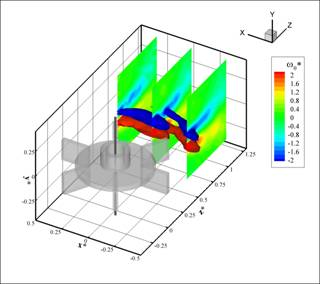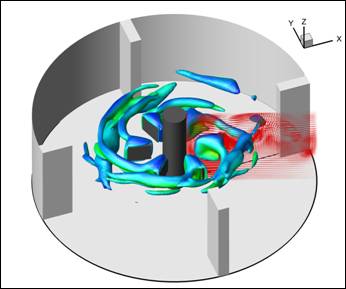
Back to Table of Contents
43857-AC9
An Integrated Numerical and Experimental Study of Scaling Effects in Stirred Tank Reactors
David F. Hill, Pennsylvania State University
An Integrated
Numerical and Experimental Study
of Scaling Effects in Stirred Tank Reactors
Second Year
Report
Overview
This project
proposed to conduct an integrated numerical and experimental study of
the
turbulent flow in stirred tank reactors.
These flows are widely used in the chemical, petroleum, and
environmental engineering industries.
Knowledge of the mean and turbulent velocity fields in these
flows is
important as the large and small scale flow structures help to control
reaction
and blending rates. The work was
motivated by the need to be able to scale up small laboratory-scale
experimental results to full prototype scale.
Presently, the literature contains many experimental studies of
these
flows. Aggregated together, the studies
span a modest range of physical scale and operating conditions. Individually, however, the studies are
individually
quite limited in terms of the range of parameter space covered. As a result of differences in experimental
configuration from one study to the next, which lead to differences in
derived
results, it is difficult to arrive at any substantive overall
conclusions about
the scaling of the flow field. The
funded project sought to conduct the most extensive set of scaling
experiments
to date. In addition, computation
simulations of the flow, using the experimental results, were performed.
Project
Management
The funded
project
spans a period of two years, which ended in August 2008, with an
unfunded
extension presently ongoing. The first
year was conducted at the Pennsylvania
State University,
under the direction of Dr. D. Hill. The
second year was conducted at the University of Florida,
under the
direction of Dr. S. Balachandar.
Work
Accomplished
- We have
completed our experimental work on the geometric and Reynolds number
scaling. Regarding the Reynolds number
scaling, we have found that the mean velocity fields collapse well over
a wide range of Re, as expected. The
turbulent velocity fields were found to approach Re invariance for
values of Re > 100,000. Regarding the
geometric scaling, we found that the scaled results from the four
differently sized experimental facilities did not collapse well,
despite the extraordinary care taken to ensure exact geometric
similarity in the facilities. This
relative lack of agreement was found both in the mean and in the
turbulent velocity fields.
- We performed
extremely unique volumetric three-component (V3V) particle image velocimetry (PIV) measurements in our
experimental facility. This technique is
able to measure the instantaneous velocity field over a finite
three-dimensional volume, yielding an extremely dense grid of velocity
data. As Fig. 1 shows, these measurements
allow, for the first time, the instantaneous visualization of the
vortex pairs that are shed by the blade tips and that are responsible
for the mixing in the tank.

Figure SEQ Figure \* ARABIC 1: Isosurfaces
(and slices) of vorticity, illustrating
the vortices
shed by the blade tips.
- We have
developed a versatile finite volume code that uses an immersed boundary
(IB) technique. This code has several
attractive features that make it suitable for the investigation of
complex geometries, such as the mixing tank, as in the present case. We have conducted several direct numerical
simulations to study the applicability of the code to present problem
of a mixing tank with Rushton impellers. During the ongoing unfunded extension of this
project, we are actively working to make the code meet our final goal,
which is to simulate a wide array of cases and find out the physical
understanding for high Re turbulent flow in a mixing tank. The improvements we are pursing include the use of Large
Eddy Simulations (LES), fully parallelized MPI (message passing
interface), scalar mixing, and the direct integration of the numerical
and experimental results.

Figure SEQ Figure \* ARABIC 2: Numerical simulation of the
flow in a
cylindrical tank stirred by a Rushton
turbine.
Project
Deliverables, Presentations, and Publications
- Hill, D.F., Troolin, D., Walters, G., Lai, W., Sharp, K.V.,
2008, “Volumetric three component velocimetry
measurements of the turbulent flow in stirred tank reactors,” 14th International Symposium on Applications of Laser
Techniques to Fluid Mechanics, July 7-10, Lisbon, Portugal.
- Sharp, K.V.,
Hill, D.F., Troolin, D., Walters, G., Lai,
W., 2008, "Volumetric 3-component velocimetry
(V3V) measurements of the turbulent flow in stirred tank reactors," Experiments in Fluids, submitted.
- Walters, G.,
2008, “An investigation of geometric scaling of mean and turbulent
flows in cylindrical stirred tank reactors,” The Pennsylvania State University,
M.S. Thesis.
- Vergara, A.,
Hill, D.F., 2008, “Destratification by mechanical mixers: mixing
efficiency and flow scaling,” Penn State College of
Engineering Research Symposium, April, University Park, PA.
- Walters, G.,
Hill, D.F., 2008, “An investigation of geometric scaling of mean and
turbulent flows in cylindrical stirred tank reactors,” Penn State
College of Engineering Research Symposium, April, University Park, PA.
In addition
to these, the PIs are presently
drafting additional manuscripts for submission in 2009.
Back to top





